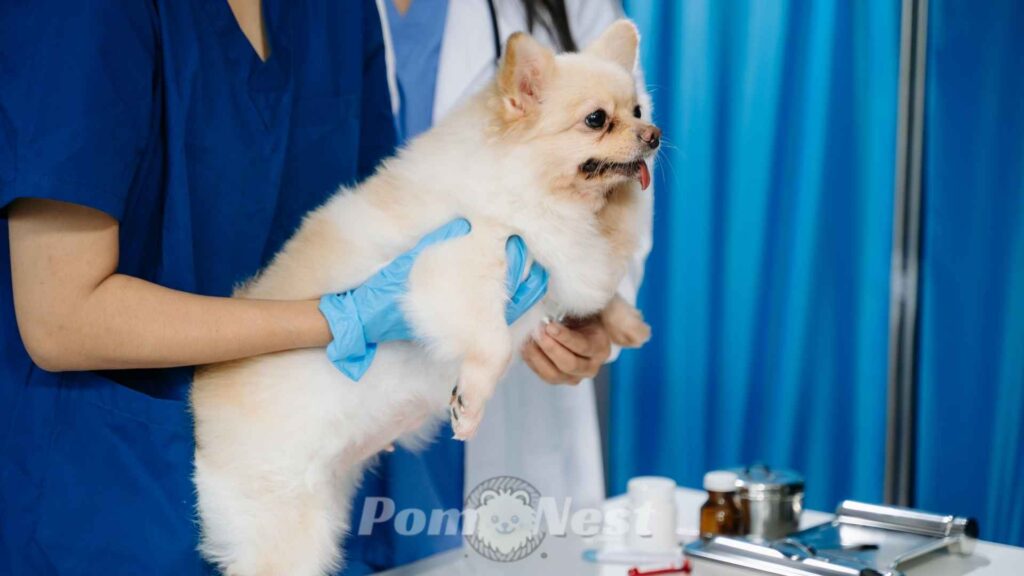Why Is My Pomeranian Shaking? Vet-Approved Causes & Fixes
If you’re asking yourself why is my Pomeranian shaking, the most common reasons are excitement, stress, or being cold, but it can signal pain or possibly a medical condition such as low blood sugar or tremors. As mentioned, identifying the cause early will help your Pom remain comfortable and healthy.

Common Reasons Why Your Pomeranian Might Be Shaking
As a tiny ball of fluff, Pomeranians are lively and cheerful companions. But when these cute dogs begin to shake, it may cause concern. Shaking can occur for a multitude of reasons, some benign and some more serious. Below are the most common explanations to help you understand the most harmless to serious explanations for your Pomeranian’s shaking.
Table of Contents
TogglePain
Dogs, just like people, shake when they’re suffering from pain. If you’ve ever wondered why is my Pomeranian shaking, it could be due to discomfort from their joints or muscles, injuries, or even arthritis if they are senior dogs. Sometimes, the pain can really be masked. Indicators of such pain can be subtle like whining, limping, or avoiding being petted.
If your Pom shaking is coupled with restless behavior and some hostile posture, a vet’s appointment will be necessary. These signs can be indicative of more serious muscle corresponding pain, dental pain and some other undiagnosed pain.
Overexcitement
A major characteristic of Pomeranians are their high spirits and playful energy. While being playful, especially during a greeting, this breed can get overly excited causing normal trembling, which will stop once the intense moment is over.
In small breeds, like Pomeranians, a temporary case of panting or trembling due to extreme hyperactivity may happen. If you’re asking why is my Pomeranian shaking, it might simply be from overexcitement. Pomeranians may need assistance to relax. Try taking attention and play breaks.
Stress, Fear, and Anxiety
Shaking Pomeranians may be experiencing their emotions in response to a trigger like a loud sound, unfamiliar place, or their owner leaving. Pomeranians may be small but they feel big emotions like fear or anxiety, leaving them trembling.
Working with a dog behavioral specialist may benefit a Pomeranian who shakes in certain situations frequently. Creating a quiet area, training, and gentle praise all take time and forethought to help take their stress levels down.
They’re too Cold
A Pomeranian has a lot of fluff, but being small, they will take a long time to warm up. If your dog comes in from a bath or is outside in chilly weather, and starts to shake, they are probably cold.
To warm your dog up and get rid of the shaking, wrap them in a towel or sweater and hold them. They will be grateful to prevent cold from taking their warmth and stopping the shaking.
Hypoglycemia or Low Blood Sugar
Low blood sugar, or hypoglycemia, is a common issue with little breeds, like Pomeranians. When a Pomeranian goes too long without eating, their blood sugar can dip too low, and make them shake, faint, or feel weak.
If your Pom gets busy playing and skips a meal, it can have this type of response. Frequent, small, and balanced meals can help prevent your Pom from unhealthy blood sugar drops. This will keep them active and healthy all day long.
Poisoning
Some foods and substances are toxic to your dog and can make them tremble. Other things that can make your Pom shake are chocolate, caffeine, xylitol and some household items.
If your Pom is shaking and has eaten something suspicious like a toxic food and is also drooling or vomiting, contact your vet. Chocolate can cause tremors and other dangerous symptoms that need quick treatment.
Nausea
Nausea can also cause your Pom to shake. Them getting car sick, overeating, or other digestive issues can make them queasy. This can include shaking, drooling, or other signs like lip licking and also a loss of appetite.
If it is due to nausea, symptoms probably are more severe. You will need to help your Pom rest for a while and ensure they are hydrated. If it happens often, your vet can help check for motion sickness or other possible digestive issues.
Injury or Physical Trauma
Your Pom shaking could also indicate that something hurts. Even a small fall or sprain can cause discomfort that leads to trembling.
Observe if your dog is limping, hiding away, or whining, as these behaviors might be signs of pain or injury. Getting a vet to take a look at any potential injuries or fractures right away is important.
Seizures or a Condition That Causes This Symptom
If your Pomeranian is shaking in a way that resembles twitching or losing control, that could be a seizure. They could also have neurological issues. Epilepsy and head trauma are also possible causes for these signs.
A veterinarian can determine whether a seizure is occurring, or if it is another condition called idiopathic generalized tremor syndrome that affects smaller breed dogs.
Shaker’s Syndrome (Generalized Tremor Syndrome)
Trembling in smaller dogs can be caused by Shaker’s Syndrome or Generalized Tremor Syndrome (GTS). This syndrome is thought to be autoimmune-related and can cause full body tremors. It can be distressing to see your Pom tremble, but there is effective treatment.
Your Pom’s comfort and recovery are directly related to how quickly the syndrome is diagnosed.
Distemper
Distemper is caused by the Canine distemper virus which is a serious illness that can lead to shaking, fever, nasal discharge, and lethargy. It can be dangerous if untreated, however it is preventable through vaccination.
If your Pom isn’t symptomatic and is not up to date on their vaccines, distemper is something that is of concern.
Medical Conditions and Illnesses (Kidney, Liver, or Neurological Issues)
Trembling can be connected to internal diseases, such as kidney and liver diseases and neurological disorders. These conditions hinder the way your Pom metabolizes toxins or the way their body coordinates movement.
In most cases, taking your Pom to the vet for routine veterinary checkups and blood work prevents these issues and allows for prompt treatment.
How to Tell If Your Pomeranian is Hurting

As a Pom owner, you have to learn how to recognize signs of discomfort, since your fluffy pup can’t tell you directly that they’re hurting. Some signs of pain can be subtle, and may include changes in behavior, the way they move, or even the position of their body. Recognizing these changes early can mean the difference between getting the care your pup needs and having the situation worse over time.
Behavior Changes and Physical Signs
Long before a dog actually cries out in pain, their body language tells a story. If your pom is shaking, limping, arching their back or refusing to move, it may mean they have muscular or joint pain. Signs that indicate pain also include panting, twitching, and certain movements’ avoidance.
Your Pom’s arrow, restlessness and aggressiveness are also behaviors that indicate pain. Refusing to eat, sleeping more than what is normal, and losing interest in play are also behaviors that indicate a dog is hurting. These are also the signs of pain in dogs that indicate the situation needs immediate care.
Some Pomeranians may also be in pain when they are excessively panting. If you have asked yourself, “why does my Pom pant so much?” a possible answer can be pain, anxiety, or even fever. Always verify other signs, before you assume your pup is excited or it is a hot day.
When Shaking Indicates a More Serious Health Issue
It’s understandable to shake a little after excitement or when the weather is cold, but prolonged shaking could indicate more serious issues, such as arthritis in older dogs, issues related to the nervous system, or internal pain.
Tremors that last for several hours, worsen, or occur with vomiting, confusion, or unsteadiness, indicate the need for the attention of a medical professional. These could signal a very serious metabolic or neurological condition that requires immediate attention.
Self-diagnosing is dangerous. Giving pain relief medication and other so-called “safe” human medication is even more dangerous. Professional veterinary care is the only way to guarantee your Pom receives the correct diagnosis and treatment.
How to Help a Dog That’s Shaking or in Pain

When a Pomeranian is shaking, most people will feel a sense of concern. However, there are many things that you can do to comfort and take care of your shaking Pom and figure out what is going on. If you are calm and take action to assist your Pom early on in the shaking, the recovery process will improve dramatically.
Veterinary Consult
To help your Pom, the first thing you must do is get a veterinarian. A vet will determine if the Pom shaking is a result of pain, anxiety, or even a medical condition. The vet may recommend physical exams, X-Rays, or blood work to find out about possible hidden causes, joint pain, muscular pain, or, idiopathic generalized tremor syndrome. After the diagnosis, your vet will help your Pom recover more comfortably with physical therapy, pain relief medication, or antibiotics.
Adjust Their Activities
When your Pom is in recovery, avoid strenuous activity and long walks. Some gentle movement is important, but overexertion is not helpful. I recommend that instead of a long walk, you take short, calm strolls or play relaxed indoor games to take stress off your Pom’s joints. This is not only easier on your Pom but is also helpful to manage arthritis in senior dogs.
Note Any Behavior Changes
Observe and note any change in behavior Pom possibly display, like not eating, too much shaking and variations in sleeping.
Document when these behaviors are presented, the duration and if anything seemed to trigger them. These observations might assist in a faster, more pinpointed diagnosis by your veterinarian. Even short videos of your Pom shaking can be very valuable.
Keep Them Warm and Comfortable
Sometimes the weather shine triggers the shaking so be mindful to wrap Pomeranians in pack blankets. Heating pads on low settings, supervised, also assist in warming them up, especially for smaller and older Pomeranians.
Reduced trembling and psychological relaxation are achieved via coziness, drafts and mentally calm environments.
Balanced Diet to Prevent Hypoglycemia
Hypoglycemia can cause small-breed dogs to tremble. Be sure your Pom gets regular meals and a decent portion of their diet should consist of proteins and healthy carbohydrates.
Puppies and very active dogs are especially prone to sugar drops, so providing small, frequent meals helps maintain steady energy levels and prevents sudden trembling spells.
Reduce Stress Levels and Provide a Tranquil Atmosphere
Moreover, dogs are able to shake when they feel anxious. Dogs may feel stress and anxiety in response to loud noises, unfamiliar people, or changes in their routine.
You may be able to foster a calming atmosphere by alleviating the noise and gradually introducing new experiences. Other owners feel anxious Pomeranians respond well to calming wraps, soothing music, or gentle hugs.
Avoid Using Home Remedies Entirely
Including home remedies may be helpful, but they are not a substitute for proper care. Warm compresses and dog massages or physical therapy may help ease slight muscle tension, but do not let dogs for people medications or essential oils because many can be poisonous to your dog.
When in doubt about a remedy’s safety, always do a veterinary consultation for dogs because it will be the most effective and safest way to manage your Pomeranian’s pain.
Preventing Shaking Episodes in Pomeranians

Pomeranians need a good, well-balanced diet to be properly hydrated and energized. A nutritional imbalance in the diet may result in low blood sugar and Pomeranians may also suffer from nausea and fatigue.
Feeding food appropriate in size for the Pomeranian and for small breed dogs will help. Also, Pomeranians should have free and easy access to water. Offering small Pomeranian appropriate snacks will help low blood sugar, and dropping blood sugar will result in shaking.**Safe Environment and Mental Stimulation**
A calm home environment can lessen stress, which in turn lessens shaking. An environment can, and should, be made calm by arranging for your dog’s surroundings to be safe. Predictable spaces help to shelter your dog from loud, rough noises, and violent handling which can be very frightening.
While mental and physical stimulation within the home environment is very important as well. Mental stimulation can be provided with your Pom and some puzzle toys, for your Pom walks and training sessions can be created, and then with all those activities combined. An adequately exercised Pom will be more calm and content, and less likely to complete an anxiety cycle.
Conclusion

When looking at all the causes for Pomeranians to shake, from stress and excitement to the cold and then much more serious medical issues, whichever is the case be sure to monitor the behaviors and patterns of the Pom so that you can be proactive in making your Pom as comfortable as possible. If the shaking continues, it is important to get your dog checked by the vet to rule out possible causes of shaking so that your dog can be in the best possible shape.
Disclaimer
The content is not intended to be a substitute for professional veterinarian advice, diagnosis, or treatment. Always seek the advice of your veterinarian with any questions you may have regarding your dog’s medical condition. Never disregard professional advice or delay seeking it because of something you’ve read on any website.
Read More:
American Kennel Club (AKC) – Why Is My Dog Shaking? Causes & Solutions
FAQs
A Pomeranian shaking could mean a number of things: harmless excitement, a chill, possible hypoglycemia, pain, anxiety, or a possible seizure disorder. To determine whether it is a normal situation or a veterinary issue, pay attention to the context when shaking occurs and any accompanying symptoms or changes.
Not necessarily, but you should be concerned if the trembling is persistent, occurs suddenly, or is accompanied by vomiting, collapse, cyanosis (blue gums), disorientation, or any sign of respiratory distress.
If your dog is shaking, you should first ensure they are warm and calm, and if necessary, provide a small snack and water for the possible low blood sugar or nausea. Then, document the episode and call your vet if it is severe, recurrent, or has any of the additional symptoms described above.
To determine if a Pomeranian is sad, watch for specific behavior changes such as loss of appetite, withdrawn behavior, decreased play, increased sleep, or excessive clinginess. These shifts in behavior in combination provide the most accurate indicator of sadness.
Certainly — with kidney disease, an animal may exhibit weakness, shaking, trembling, lethargy, nausea, and other systemic illnesses, and if shaking accompanies vomiting, decreased urination, and an absence of appetite, this should be swiftly investigated with veterinary testing.
